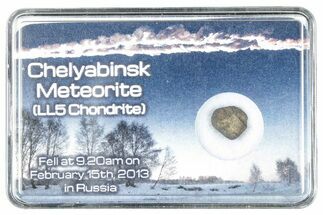This Specimen has been sold.
.57" Chelyabinsk Meteorite (2.46 g) - 2013 Witnessed Fall
This is a .57" wide (2.46 grams) Chelyabinsk meteorite from the largest meteorite fall in the past century. It comes in an acrylic display case.
The Chelyabinsk Meteorite - 2013 Witnessed Fall
On February 15th, 2013 at 9:22 a.m. local time, a tremendous fireball lit up the sky over the city of Chelyabinsk in southwest Russia. Shortly afterwards, a massive shockwave reported to be equivalent to a 300 kiloton explosion rocked the area. Windows were blown out in thousands of buildings and nearly 1,000 people were injured, primarily from flying glass. Some residents reportedly thought nuclear war and begun and the world was about to end.
The cause of this destruction was a meteor estimated 55 feet wide that had entered Earth's atmosphere before exploding 18 miles above the surface. This is believed to be the largest meteor to enter our atmosphere since the Tunguska meteor more than a century earlier.
Most of the meteor vaporized during the airburst, but thousands of small stones, most only weighing a few grams, rained down around several villages about 40 kilometers Southwest of Chelyabinsk. The meteorite stones and fragments ranged from less than a gram to 1.8 kilograms in weight. The total mass collected by local people is estimated to be between 100g and 1000 kilograms. Most of these stones have a black or brown fusion crust.
Meteoritical Bulletin: Entry for the Chelyabinsk Meteorite
On February 15th, 2013 at 9:22 a.m. local time, a tremendous fireball lit up the sky over the city of Chelyabinsk in southwest Russia. Shortly afterwards, a massive shockwave reported to be equivalent to a 300 kiloton explosion rocked the area. Windows were blown out in thousands of buildings and nearly 1,000 people were injured, primarily from flying glass. Some residents reportedly thought nuclear war and begun and the world was about to end.
The cause of this destruction was a meteor estimated 55 feet wide that had entered Earth's atmosphere before exploding 18 miles above the surface. This is believed to be the largest meteor to enter our atmosphere since the Tunguska meteor more than a century earlier.
Most of the meteor vaporized during the airburst, but thousands of small stones, most only weighing a few grams, rained down around several villages about 40 kilometers Southwest of Chelyabinsk. The meteorite stones and fragments ranged from less than a gram to 1.8 kilograms in weight. The total mass collected by local people is estimated to be between 100g and 1000 kilograms. Most of these stones have a black or brown fusion crust.
Meteoritical Bulletin: Entry for the Chelyabinsk Meteorite
About Chondrites
A chondrite is a stony (non-metallic) meteorite that has not been modified by either melting or differentiation of the parent body. Chondrites are formed when various types of dust and small grains in the early Solar System accreted to form primitive asteroids. Some such bodies are captured in the planet’s gravity well and pulled to the surface. They are by far the most common type of meteorite, representing about 86 percent of all meteorites that have fallen to Earth.
Prominent among the components present in chondrites are the enigmatic chondrules, millimeter-sized spherical objects that originated as freely floating, molten or partially molten droplets in space; most chondrules are rich in the silicate minerals olivine and pyroxene. Chondrites also contain particles of various metals such as nickel, iron, and aluminum. These formed at the very beginning of the solar system and aggregated over time: they are the oldest rocks known on Earth!
Chondrites are divided into about fifteen distinct groups on the basis of their mineralogy, bulk chemical composition, and oxygen isotope compositions. The various chondrite groups likely originated on separate asteroids or groups of related asteroids. Each chondrite group has a distinctive mixture of chondrules, refractory inclusions, matrix (dust), characteristic chondrule sizes, and other components. Other ways of classifying chondrites include weathering and shock. The L chondrite group is the most common of these.
A chondrite is a stony (non-metallic) meteorite that has not been modified by either melting or differentiation of the parent body. Chondrites are formed when various types of dust and small grains in the early Solar System accreted to form primitive asteroids. Some such bodies are captured in the planet’s gravity well and pulled to the surface. They are by far the most common type of meteorite, representing about 86 percent of all meteorites that have fallen to Earth.
Prominent among the components present in chondrites are the enigmatic chondrules, millimeter-sized spherical objects that originated as freely floating, molten or partially molten droplets in space; most chondrules are rich in the silicate minerals olivine and pyroxene. Chondrites also contain particles of various metals such as nickel, iron, and aluminum. These formed at the very beginning of the solar system and aggregated over time: they are the oldest rocks known on Earth!
Chondrites are divided into about fifteen distinct groups on the basis of their mineralogy, bulk chemical composition, and oxygen isotope compositions. The various chondrite groups likely originated on separate asteroids or groups of related asteroids. Each chondrite group has a distinctive mixture of chondrules, refractory inclusions, matrix (dust), characteristic chondrule sizes, and other components. Other ways of classifying chondrites include weathering and shock. The L chondrite group is the most common of these.
TYPE
Chondrite (LL5)
LOCATION
Chelyabinskaya Oblast, Russia
SIZE
.57 x .44 x .41", 2.46 grams
CATEGORY
SUB CATEGORY
ITEM
#267410
 Reviews
Reviews












